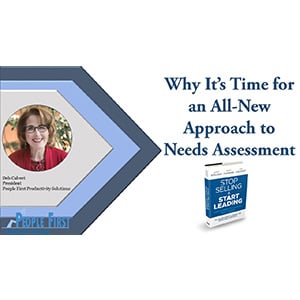
It’s time to transform the old-school, sounds-like-a-survey, ho-hum needs assessment interview into a rich, engaging two-way dialogue with buyers. Why?
Because:
- Buyers don’t have time or patience for sellers’ self-serving Socratic questions.
- Buyers don’t want to be sold and resist sharing information that overtly sets up the sale.
- Buyers don’t see value in the recycled questions every seller pulls out of the same old playbook.
That well-worn playbook prescribes that sellers ask questions to:
- Understand the background and current state of the buyer
Ex: How much overtime are you averaging each month on the production line?
- Probe the buyer’s known needs and uncover latent needs
Ex: What is your target for first quarter expense reductions on the production line?
- Spotlight risks and consequences of inaction
Ex: What happens if you don’t meet or exceed those targets for expense reduction?
- Magnify the urgency and impact of adopting a new solution
Ex: If you don’t act soon and get those savings in the first month, how much more intense will the pressure be in February and March?
- Build buyer desire by showcasing potential benefits with a new solution
Ex: If you did achieve those expense reductions, what would that mean to your career?
Following the playbook takes more time than buyers want to spend on Q&A, especially when questions seem aimless or endless (as they so often do with sellers who aren’t purposeful in crafting their questions). When sellers ask formulaic questions they confirm buyers’ beliefs that all sellers are the same. For buyers, these kinds of questions are value-subtracting, not value-adding. For sellers, these kinds of questions diminish differentiation and buyer trust.
As a result, sellers frequently leapfrog over the needs assessment portion of the sales process. Instead, they make assumptions about customer needs. Even when assumptions are accurate, these sellers lose sales. That’s because buyers need to figure out, declare and take responsibility for their needs. A solid needs assessment facilitates buyer awareness and the buyer’s progression toward action. But sellers who sense buyer disdain for the needs assessment interview rationalize that no assessment will be more efficient and more acceptable to the buyer. So…they skip it altogether.
Old school assessment no longer works.
Skipping the assessment doesn’t work.
Transforming the needs assessment is the only viable alternative.
Organizational development guru Edgar Schein succinctly describes the desirable alternative this way. “Sales conversations need to move from diagnostic to dialogic.” Let’s break it down to understand the difference.
For decades, we’ve all been conducting diagnostic interviews during the needs assessment phase of our sales processes. We’ve become like the stereotypical physician who gives the patient a cursory once-over, asks a few questions about symptoms, and swiftly writes a prescription. As a patient, this feels impersonal, one-sided, and unsatisfactory… especially since we’ve done our online research before the appointment and have questions and concerns beyond what the doctor is focusing on.
As patients, we want to have meaningful dialogues with our doctors. We are looking for an exchange of ideas, opinions, and thoughts. We want to be involved in and consulted about our own care. We’re seeking professional advice, but we’re empowered enough to challenge it and want to understand what’s being done and why, along with all the alternatives.
Our buyers are no different. They resent the cookie cutter diagnostic interview that produces a clinical solution. According to Forrester, only 19% of buyers say that time spent with sellers is valuable. Buyers say it’s a waste of time to meet with a seller who can’t or won’t do more than write a generic prescription.
The dialogic conversation is different. Its hallmark is the full and equal engagement of both parties. In a dialogic conversation, the seller asks questions to:
- Engage the buyer in brainstorming about possible solutions
Ex: What have your competitors been doing to trim expenses?
- Co-create insights with the buyer (instead of the seller delivering his or her own insights)
Ex: What are some of the positive influences on productivity you’ve experienced before?
- Make the buyer think and to look at the situation in new ways
Ex: Give me a comparison. What do your employee engagement surveys reveal about the productivity levels of your most satisfied and least satisfied crews?
- Ascertain (and help the buyer determine) what is of the greatest value at this time
Ex: What matters most to you about this situation and why?
- Collaborate and get the buyer participating in creating what he or she wants
Ex: Describe for me exactly what your ideal staffing solution would include.
Dialogic conversations are necessitated by the emerging realities of what attracts buyers. In “The Future of Competition,” CK Prahalad and V Ramaswarmy wrote these prophetic words: “Consumers will migrate to businesses that allow them to be participants in creating what they want.”
Diagnostic needs assessments deny buyers the opportunity to participate in creating what they want. The diagnostic interview forces a buyer to take a passive role.
To get buyers to migrate to you, make space for them in the needs assessment conversation. Think of yourself as a leader, inspiring and challenging buyers with thought-provoking questions and enabling their active participation in creating what they want.
Your buyers will reward you when you make this shift. In a recent Qualtrics panel study, we asked 530 B2B buyers about their preferences regarding seller behaviors. Buyers unanimously told us they want to see a higher frequency of key leadership behaviors exhibited by the sellers they’ll choose to do business with. (You can learn more about this in the new book Stop Selling & Start Leading.)
Right at the top of that list are behaviors that leaders exhibit to enable others. Sellers must enable their buyers to participate in creating what they want and involve them in engaging dialogue right from the start of the relationship. A dialogic approach to needs assessment demonstrate leadership, creates value for the buyer, and advances the sale.
 Deb Calvert is the President of People First Productivity Solutions and the Founder of The Sales Experts Channel. She is the author of Stop Selling & Start Leading® and DISCOVER Questions® Get You Connected (one of the “Top 20 Most Highly-Rated Sales Books of All Time”). Deb has been named one of the “65 Most Influential Women in Business” and a top 50 Sales Influencer. Additionally, she teaches sales courses at UC-Berkeley and is a Certified Master of The Leadership Challenge®, a Certified Coach, and an in-demand Sales & Leadership Speaker and Trainer.
Deb Calvert is the President of People First Productivity Solutions and the Founder of The Sales Experts Channel. She is the author of Stop Selling & Start Leading® and DISCOVER Questions® Get You Connected (one of the “Top 20 Most Highly-Rated Sales Books of All Time”). Deb has been named one of the “65 Most Influential Women in Business” and a top 50 Sales Influencer. Additionally, she teaches sales courses at UC-Berkeley and is a Certified Master of The Leadership Challenge®, a Certified Coach, and an in-demand Sales & Leadership Speaker and Trainer.
Share This Story, Choose Your Platform!
What our happy clients are saying
Let Us Help You Source the Sales Talent You Need
Whether you’re building a team or replacing a key role, our Candidate Sourcing Platform provides a fast, flexible, and employer-focused solution.
Tell us more about your business and how we can help.
Treeline Inc.
Your Award-Winning Sales Recruitment Partner
15 Lincoln Street, Suite 314, Wakefield, MA 01880












